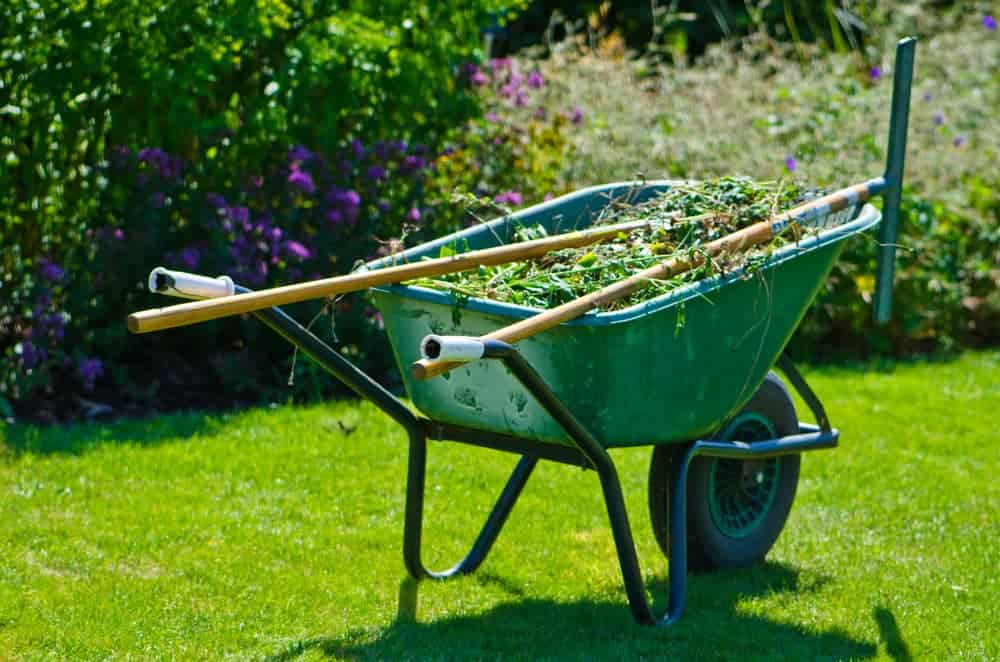One of the most annoying problems for the people who regularly use wheelbarrows such as gardeners, landscapers, construction workers, and farmers is a flat tire. A flat tire is not only a nuisance to your workday but also it is a waste of time and energy to fix or replace. Thank God, flat-free tires can be a great alternative that makes it easy for people to continue their activities while causing them fewer headaches, providing a long-lasting solution, and thus being convenient for users as well as professionals and hobbyists.
Within this manual, we will get to know the benefits of flat-free tires as a game-changer, draw a parallel between them and the regular pneumatic tires, and figure out how to pick out the perfect flat-free tire for your wheelbarrow. By the end, you'll see how flat-free tires can enhance your effectiveness, lead to time-saving, and reduce your long-term costs.
What Are Flat-Free Tires?
Flat-free tires are tires that are not able to flatten, as their name says. The solid rubber or polyurethane foam is among those durable materials the flat-free tires are made of, other than a typical tire filled with air. These tires can neither be punctured, nor can they deflate, no matter what attack they undergo, and are therefore a better choice than those filled with air. These are most often the type of tires that you would find at construction sites, farms, and gardens, and one needs to be tight so the thorns, rocks, and twigs don't affect the tires.
There are two main types of flat-free tires:
Solid Rubber Tires: These tires are formed from rubber compounds that are very dense and are highly wear-resistant thereby offering long-lasting durability. They are used mostly for large-scale work such as the movement of a wheelbarrow that is loaded onto very rough terrain.
Foam-Filled Tires: The tires mentioned above consist of polyurethane foam. This impersonates the resonance of a pneumatic tire but stays infinitely flat. Insulating tires with foam are widely found in manufacturing/architecture industries working on them, who prefer it due to their quiet and smooth operation and shock absorption, which makes it a good choice for landscaping or gardens.
Flat-free tires means no more checks for air pressure, no more flats fixed, inflation, or repair as punctures eliminate the problem. This also brings greater convenience, not to mention a lot less downtime, during which you would be able to handle the job in question without any break.
Key Benefits of Flat-Free Tires
Ditching airless tires brings a host of benefits for people using wheelbarrows on a regular basis. In detail, here are the advantages of the switch:
- No More Flat Tires
The first advantage is quite clear: With no flat tires, you can't use flat-free tires. Or, as to say, if you've ever been faced with a flat tire on your wheelbarrow, you know how upsetting it can be if you're using nails, thorns, or glass. In such cases, flat-free tires become the best option.
The tires are engineered to resist tough environments. Undoubtedly, the non-pneumatic wheel fatigue may be difficult to cope with for the widely scattered across rocks and pieces of equipment. nailing working endures. Thereby, the electric line of the army, which lacks the cap to resist, needs to frequently renew the old tires by attracting the newcomers. Therefore repping of the army is the key to an electric facility and the fulfillment of the task without any difficulties.
- Low Maintenance
Zero maintenance is needed for the build of flat-free rubber tires. More specifically, pneumatic tires need to be checked for air, added crushed stones, or patches for the holes. Later on, from the pumping and letting the air out of the tire, they become thin and require replacement. In the case of flat-free tiers, all these problems are eliminated. These tires work independently of air pressure or leakage and do not need the most-recommended repairs of patches and leaking air.
Wheelbarrows equipped with flat-free tires are practical items for having landscapers skilled in the layout of a garden to work throughout the day without any hindrance caused by a flat tire. You won't have to check the tires' air pressure every now and then, therefore, you can focus on the elimination of materials with the highest efficiency.
- Durability and Longevity
Flat-free tires made of rubber or foam are built to last. The robustness of their design is such that they can cope with heavy use in adverse conditions without any rapid fatigue due to the wear of their material. As opposed to the traditional pneumatic tires, which can soon develop defects as a result of operating on frequent rough surfaces, flat-free tires can handle uneven, rocky landscapes very easily.
Flat-free tires are commonly used by building professionals in wheelbarrows specifically designed to carry heavy materials such as concrete or gravel. They are usually less prone to warping under the weight of the material, thus ensuring the wheelbarrow remains always balanced irrespective of its load. Their durability in the long run makes them a rather budget-friendly solution for tough working conditions.
- Consistent Performance
Flat-free tires deliver the same consistent performance on different surfaces. In case they are not used for weeks, they will not deflate but will rather remain in the same condition. This is particularly so in the construction and farming industries, where wheelbarrows are commonly stored for long periods.
If you happen to be a farmer who is in need of means or equipment to transfer crops, tillages, and soil in the situation where we have rugged terrain, the flat bench is a broken record for that. They are not likely to lose out, if kept in the garage, and so they remain the same always when you happen to bring them into play.
- Improved Safety and Stability
Flat-free tires boasts more effective stability, hence diminishes the danger of accidents. On wheelbarrows with flat-free tires a person carrying some heavy or uneven mass on the vehicle is less likely to tip over because the tires are still standing under the weight and stay very steady. These heavy materials are especially hard on construction workers with no added stability or no landscapers who are certainly the harassed intermediaries, they are forced to move heavy materials and carry big plants and mulch rather far from the point of production to the site of use.
Equally important, solid or foam-filled tires provide larger tire-footprint-to-ground force so you slip or stuck in mud or soft soil less frequently. This makes them more preferable to use under harsh conditions and thus ensures both smoother and more dependable material moving.
How to Choose the Right Flat-Free Tire
It's quite crucial to note that all tires that are flat never made equal. To maximize the use of your investment, it is essential that you select the best alternative based on your particular situation. Here are some key factors to consider:
- Type of Work
What type of work are you not doing and how are the barrow wheels being used? Are you mainly transporting bricks and cement through bumpy terrain that is so rough or are you being entrusted with soft objects like soil and small plants on a parklike flat ground?
For example, in most cases, solid rubber tires come in quite handy for construction or farming. They can bear much more weight and they are not likely to be worn out by the harsh conditions.
However, for less demanding gardening or landscaping, a pneumatic tire that is filled with foam means no tripping and in addition to that, a user can easily move the truck over a grassy area or around the lawn flowerbeds as compared to if it were using solid rubber tires.
- Terrain
Terrain would be the first factor to consider in selecting the right tire. For instance, your entertainment options will be quite different than if you were working in a location where there are more rocks. Solid rubber tires have been designed mainly to deliver greater durability and resistance. Additionally, these are generally better for really harsh, irregular road conditions. They could keep much longer than other tires.
Realistically, the scenes in which landscapers are involved can be as different as the people working there. Thus, the workers who have to deal with the hard and soft textures of ground, "city parks with smooth paths" and "rural gardens with rougher soil" respectively, choose the same tire. To mention a scenario, lime makers working in the inner city and groundsmen with rough soil in the country could still exploit a one-tire system with a foam-filled tire.
- Load Requirements
Material weight should be the first thing to consider. A heavy-weight job needs to have a tire that has more load capacity, while a lighter job can be done using tires which are more maneuverable and absorb more shock.
Heavy solid rubber tires are the most suitable for heavy applications.
They do not only possess unmatched strength and support but also provide adequate static friction, which makes them the most suitable. On the other hand, air-filled tires might be energy-efficient in such applications in that they would absorb shocks and help mitigate heavy loads.
- Wheelbarrow Compatibility
Before buying a flat-free tire, be sure to check the product description on whether it is compatible with your wheelbarrow. Flat-free tires generally come in several sizes, so it is advised that you measure the tire's dimensions that you have to see if it would fit. Though most manufacturers offer standard sizes, which should be the one you are looking for, take care to cross-check just to be accurate before giving the money.
Cost vs. Long-Term Savings
Although flat-free tires may be pricey initially in comparison to pneumatic tires, the long-term benefits far surpass the up-front costs. As the flat-free tires are maintenance-free, the cost of air pumps, patches, and tire replacement will be notably reduced.
For professionals like contractors or landscapers, the reduced downtime from flat tires translates into greater productivity and fewer delays on the job. These tires can decrease the time when you have to fix flat tires or wait for a new one to be delivered. The jobs will not stop because the project will continue to move on smoothly without you having to do tire repair or tire replacement. In due time, flat-free tires come to be the most price competitive way due to a lot of cost savings on labor, equipment, and replacement expenditures.
Furthermore, flat-free tires serve a longer duration, which lessens the need for replacements, hence, contributing to less consumption. This is a benefit in that it will further cut down on the spending on new tires in the longer term, thus making them even more cost-effective.
Installation and Maintenance Tips
Flat-free tires are pretty simple to install and require almost no maintenance after installation. Here are a few steps:
Installation: You can fit most flat-free tires on without any specialized equipment like a wrench and a hammer. Ensure the tire runs smoothly on the wheelbarrow by following the manufacturer's instructions on how to install it correctly.
Maintenance: But, Abu mentioned that no pressure checks or repairs need to be done on flat-free tires. It's still better to check the tread from time to time because of the rain and snow, which aggravates the situation of the tire. If the tires start to deteriorate, the new tire will be the way to go as treads will be even, hence reliable and safe. On top of that, when stored in a dry and covered place, the tire not working would mean the vehicle not being exposed to heat and moisture.
Versatile and Agile
The production of flat-free tires in various sizes and different tread patterns is their major advantage; hence, they can be employed for several purposes and in various conditions. A flat-free tire is a particular one for each purpose either you are working in a garden, a construction site, or a farm.
Where in the making of a garden can we find environments with a smooth flow of delicate plants without the usage of foam-filled tires?.
Treaded solid rubber tires offer ruggedization for the equipment used by landscapers who, for instance, are tasked with the transportation of mulch and soil and face the challenge of uneven and rough terrain.
The accessibility of flat-free tires and the ability to use them in different purposes is the most profitable investment for someone who wants to buy a wheelbarrow.
Flat-free tires of wheelbarrow are amazing solution for people, as it is not only a way of increasing the work volume, but also a way of minimizing the costs of maintenance and obtaining the expected results without any delay. Planting in the garden, opting for the construction of terraces or a load of heavy loads on the farm, flat-free tires make a powerful, cost-effective option to you.



